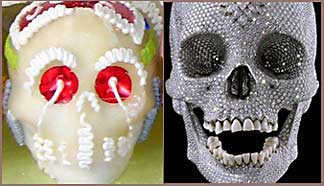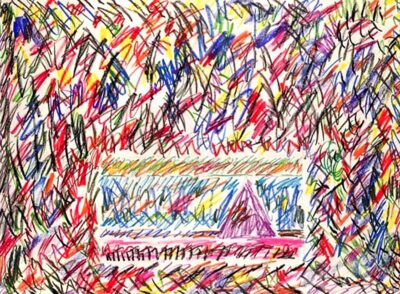An Art World Mesmerized by Bling
As the world burns and international financial institutions fall like so many dominoes, impulsive oligarchs and imprudent investment bankers continue to put their money into the overheated contemporary art “market.” At a two-day Sotheby’s London auction of works by postmodernist Damien Hirst, the artist made a whopping $169 million before the auction even closed.
Among the masterpieces snatched-up; The Kingdom, a tiger shark preserved in a tank of formaldehyde ($17.2 million), and The Golden Calf, an embalmed calf with hooves and horns of 18-carat gold, also encased in a tank of formaldehyde ($18.6 million). Hirst, who did not attend the auction but monitored sales from his home, brashly stated: “I love art, and this proves I’m not alone and the future looks great for everyone.”
While it is easy to carp about the debauchery of the elite art world, it takes considerable effort to understand how the enjoyment of art has been substituted with the worship of celebrity artists and an effusive fawning over their ridiculously excessive prices. The esteemed art critic Robert Hughes said the following about Damien Hirst in an article published in the U.K. Guardian:
“Actually, the presence of a Hirst in a collection is a sure sign of dullness of taste. What serious person could want those collages of dead butterflies, which are nothing more than replays of Victorian decor? What is there to those empty spin paintings, enlarged versions of the pseudo-art made in funfairs? Who can look for long at his silly sub-Bridget Riley spot paintings, or at the pointless imitations of drug bottles on pharmacy shelves? No wonder so many business big-shots go for Hirst: his work is both simple-minded and sensationalist, just the ticket for newbie collectors who are, to put it mildly, connoisseurship-challenged and resonance-free.
Where you see Hirsts you will also see Jeff Koons’s balloons, Jean-Michel Basquiat’s stoned scribbles, Richard Prince’s feeble jokes and pin-ups of nurses and, inevitably, scads of really bad, really late Warhols. Such works of art are bound to hang out together, a uniform message from our fin-de-siècle decadence.
(…. ) The now famous diamond-encrusted skull, lately unveiled to a gawping art world amid deluges of hype, is a letdown unless you believe the unverifiable claims about its cash value, and are mesmerized by mere bling of rather secondary quality; as a spectacle of transformation and terror, the sugar skulls sold on any Mexican street corner on the Day of the Dead are 10 times as vivid and, as a bonus, raise real issues about death and its relation to religious belief in a way that is genuinely democratic, not just a vicarious spectacle for money groupies such as Hirst and his admirers.”

Charles Thomson, co-founder of the international Stuckist movement of figurative realist artists, said this about Hirst and the Sotheby’s auction:
“The auction shows only that some people have more money than sense, and certainly more money than artistic insight. Hirst repeats ideas that are already in common currency, but merely makes them a larger size, gives them a pretentious title and puts them in an inappropriate context of art. If the same items were in a gift shop at the seaside, nobody would bother looking twice at them. It shows the triumph of marketing over substance, and operates on the same level as a craze in the school playground for Teletubbies or Teenage Mutant Ninja Turtles.
The art world has historical precedents, such as the 1875 painting The Babylonian Marriage Market by auction record-breaking Victorian artist, Edwin Long, whose work fell to 10% of its previous value after his death and who is now forgotten. William-Adolphe Bouguereau was the must-have star of the 19th century French Salon. By the 1950s museums were giving his work away to get rid of it. Now he has become modestly collectible as representative of a certain affectation of the period, but his work has never regained its peak value or status. Hirst is fashionable, and fashion doesn’t last. Worse than that, it later looks ridiculous.
It is significant that collectors ahead of the game, such as Charles Saatchi and Helly Nahmad – both major fans in the past – have already offloaded their Hirsts. The art world is a pass-the-parcel game, and the last person holding the parcel is the loser, when everyone else decides they don’t want to play any more. Eventually some people are going to lose a lot of money. It’s the same blind money-for-nothing mentality that created the sub-prime lending disaster. As Oscar Wilde said, ‘Never buy anything because it is expensive.'”
Sotheby’s Hirst auction is the ultimate spectacle to come from a certain layer in the art world that has, from top to bottom, completely lost its way. It is the end result of the philosophy best expressed in 1975 by Andy Warhol, who wrote – “Making money is art, and working is art, and good business is the best art.” The Golden Calf indeed.





